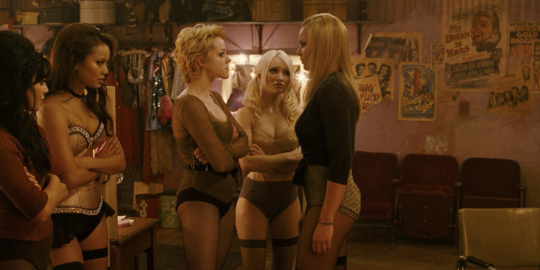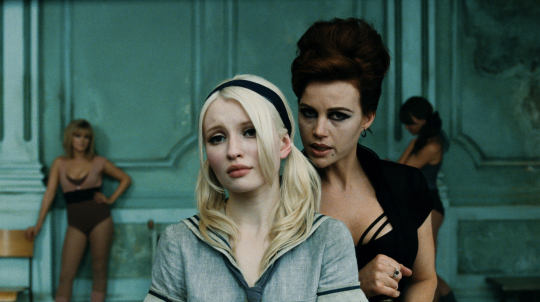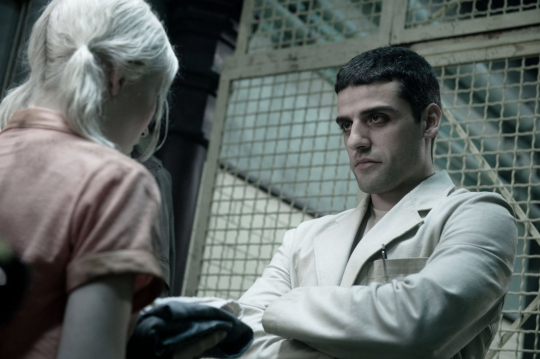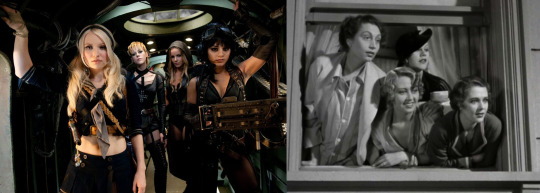Remember My Forgotten Women: The Dire Worlds of Sucker Punch and Gold Diggers of 1933 by Sheila OMalley
By Yasmina Tawil

Halfway through my first viewing of Zach Snyders Sucker Punchas I tried to disengage from the negative criticism floating around the film, as I admitted I was not only getting sucked in, I was actually moved by all of ita confused thought drifted into my head: Am I crazy, or is this a little bit like Gold Diggers of 1933? (Thats a rhetorical question, although I can already hear the response.) The thought was so ludicrous it felt like a hallucination, not to mention a sacrilege, but it kept nagging at me. Maybe 15, 20 minutes after that, theres a scene where the evil pimp-orderly Blue Jones (Oscar Isaac) comes into the rebellious girls ratty dressing room to read them the riot act. On the wall is a collage of old movie posters, and I got a brief flash of the words GOLD DIGGERS behind his head. I paused the film, and squinted at the screen.
The posters I could make out were:
Night and Day, the 1946 biopic about Cole Porter, starring Cary Grant.
Blues in the Night, the 1941 film about a guy putting together a jazz band.
My Dream is Yours, the 1949 musical where Doris Day replaces a singer in his popular radio show.
Thank Your Lucky Stars, the 1943 film about a wartime charity show, starring Eddie Cantor as himself.

Most notably, though, there was not one, not two, but three posters for various Gold Diggers film. (There had been many in the franchise: The Gold Diggers (1923), Gold Diggers of Broadway (1929), Gold Diggers of 1933/1935/37released in each respective year, and Gold Diggers in Paris (1938).) The three overlapping posters created bristling antlers out of the word Gold Diggers flar-ing out around Oscar Isaacs head.
These posters were obviously deliberate choices. Each movie is a musical about a musical, films about creating music, about putting on a show. The posters are a statement of intention. Or, at least, a statement of aspiration. They place Sucker Punch in a continuum, and, in a way, tell us how to watch the film. Starting out with a shot of a gloomy old-fashioned proscenium with dark curtains, Sucker Punch is a version of the backstage musical, complete with dance rehearsals filled with the pressure of putting on a good show. Gold Diggers of 1933, the best of the Gold Diggers films, casts a shadow longer than Sucker Punch can ever hope to do, but the two films operate in similar ways, using dizzying artificial worlds of fantasy as a bulwark against the harsh realities of life beyond the lights. But something happens in both films: the fantasies shine the spotlight onto urgent social and political concerns, and so they are not just escapes from reality. They expose reality.
The four scrappy tap-shoed Gold Digger girls trying to survive in a harsh world arent dissimilar to the five scrappy leotard-wearing girls in Sucker Punch, trying to escape the confines menand a lunatic societyhave put on them. The characters in both films discover escape hatches through elaborately staged numbers. (In Gold Diggers, its the kaleidoscopic vision of choreographer Busby Berkeley; in Sucker Punch, its the alternate universes Babydoll creates whenever she dances.) These numbers reflect and distort the action going on just offstage. They are meta-commentaries on material that is already somewhat meta.

Critics scorched the earth so much in response to Sucker Punch that one might be inclined to tiptoe into the landscape tentatively, but this is ridiculous. You dont have to defend a movie as though it’s a criminal. At the time of its release, there were a handful of criticsDanny Bowes, Sonny Bunch, and Betsy Sharkey, among themwho wrote about the film in a way I found intriguing. In their words, Sucker Punch sounded ambitious, bold, and maybe a little bit dumb. But also interesting. Ambitious failures are often more compelling than connect-the-dots successes. I found some of the defenses unconvincing (outside of the trio of writers I mentioned), in particular the its a film about female empowerment! chorus, written by mostly young male writers. (Anna Biller, director of the great The Love Witch, handled that type of argument once and for all in a recent essay, not about Sucker Punch but about the need, in general, to label films we love as feminist" in order to justify loving them.) The queasily mixed messages of Sucker Punch are part of its unnerving mood, but it doesnt need to be labeled as feminist or its about empowerment! in order to justify engaging with its onslaught of ideas and emotions. If you compare Sucker Punchs critique of societys treatment of women to a film like Chantal Akermans Jeanne Dielman, it seems like a pretty silly and surface-level story. And it is.
But Sucker Punch shows enormous empathy for the double-bind of women, the damned if you do/dont realities of sexuality, the survival techniques women create to deflect how the world sees them. The film goes after a gaslighting patriarchal culture where women are, metaphorically, either in a mental institution or a brothel. Nobody will just let women be. Its world is a world run by men with a vested interest in keeping women divided and conquered. (One of the best parts of Sucker Punch is the cooperation and sympathy among the women. Even when they argue, there is space for different opinions. Gold Diggers of 1933, too, doggedly refuses to pit the women against each other. Even Ginger Rogers, the only one whos truly a gold digger, is treated with eye-rolling humor by the others. Its far closer to the actual reality of female friendship than a catfighting competition.) Sucker Punch pursues its targets with a CGI-generated sledgehammer wielded by a ponytailed girl in a babydoll dress. Its vision is hallucinatory and exaggerated, but the exaggeration makes its points in a refreshingly clear way.

The 6-minute prologue in Sucker Punch lays out the horrifying backstory of Babydoll (Emily Browning), all to the accompaniment of Brownings whispered, dirge-like rendition of Sweet Dreams Are Made Of This. The sequence is both ridiculous and a tour de force. I responded so strongly to the pain and pleasure of the images I wondered how much I was being manipulated. I answered my own question: This is total manipulation, but its extremely effective. Every scene surges with a barely controlled sense of injustice, desperate wish-fulfillment, outrage, and hope so strong its indistinguishable from loss. The world is one of Dickensian depravity poured through the paranoid filter of Ken Kesey. The message is way larger than the messenger.
Babydoll is thrown into an institution for the criminally insane, after accidentally killing her sister during a scuffle with their evil stepfather. Oscar Isaac, with Errol Flynn mustache, plays the subversive orderly, assuring Babydolls stepfather a lobotomy has been scheduled for next week. He leads Babydoll into what is known as the theatre, a gigantic echoing space where the other patients act out their aggressions, all under the watchful eye of Dr. Vera Gorski (Carla Gugino). Jon Hamm arrives to perform the lobotomy and Babydoll launches herself into a fantasy where the asylum is actually a brothel/strip club, with trapped girls entertaining high-rolling clients. The other girlsSweetpea (Abbie Cornish) and her sister Rocket (Jena Malone), Blondie (Vanessa Hudgens) and Amber (Jamie Chung)take Babydoll under their wing. In a cavernous rehearsal room, Babydoll is told by Guginonow a den-mother who clearly started out as one of themto dance. Babydoll sways back and forth and suddenly an entire world erupts, a world where she fights (and slays) a trio of gigantic samurai-robots. She is also given the tools for her escape by a character who shows up in each fantasy called Wise Man, played by Scott Glenn. When the number stops, everyone in the rehearsal hall is breathless and awestruck by her.

Throughout the rest of the film, Babydoll is called upon to dance over and over again to distract their male captors as the girls gather together the items they need to break free. Each dance creates a different universe. After the Samurai-Robot Ballet comes the Orc-Infested Battle of Leningrad, the Steampunk Nazi Show-down, the Fire-Breathing Dragon Tussle, and the Ticking Bomb on a Speeding Train Finale. In each, the girls transform into an Inglourious Basterds team of misfit Commandos, swaggering through danger, obliterating anything in their path. Zach Snyders imagination is on bombastic overdrive, but all of the actresses bring real feeling to the table. The film is Gothic horror, melodrama, and a music video, propelled by real trauma.


